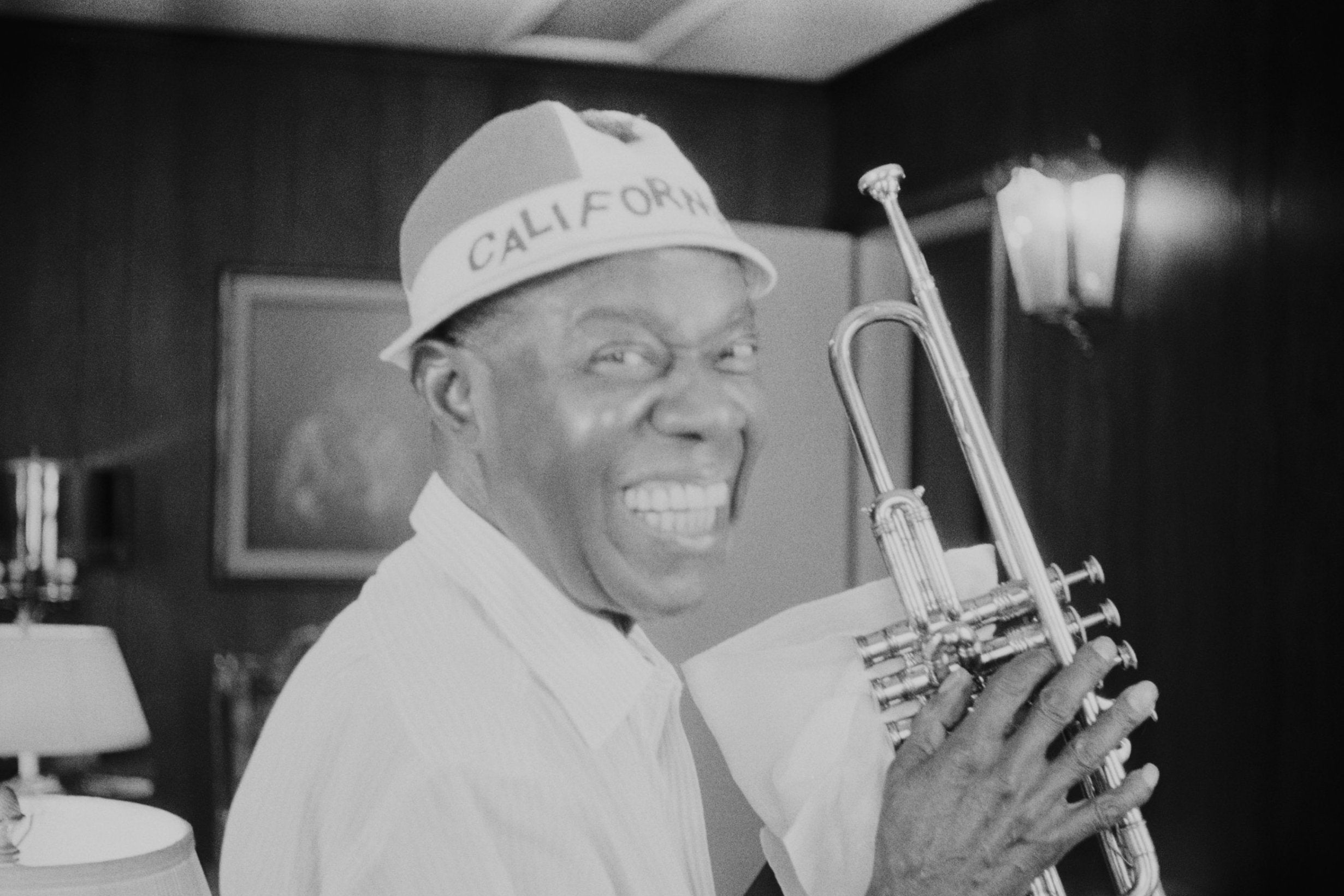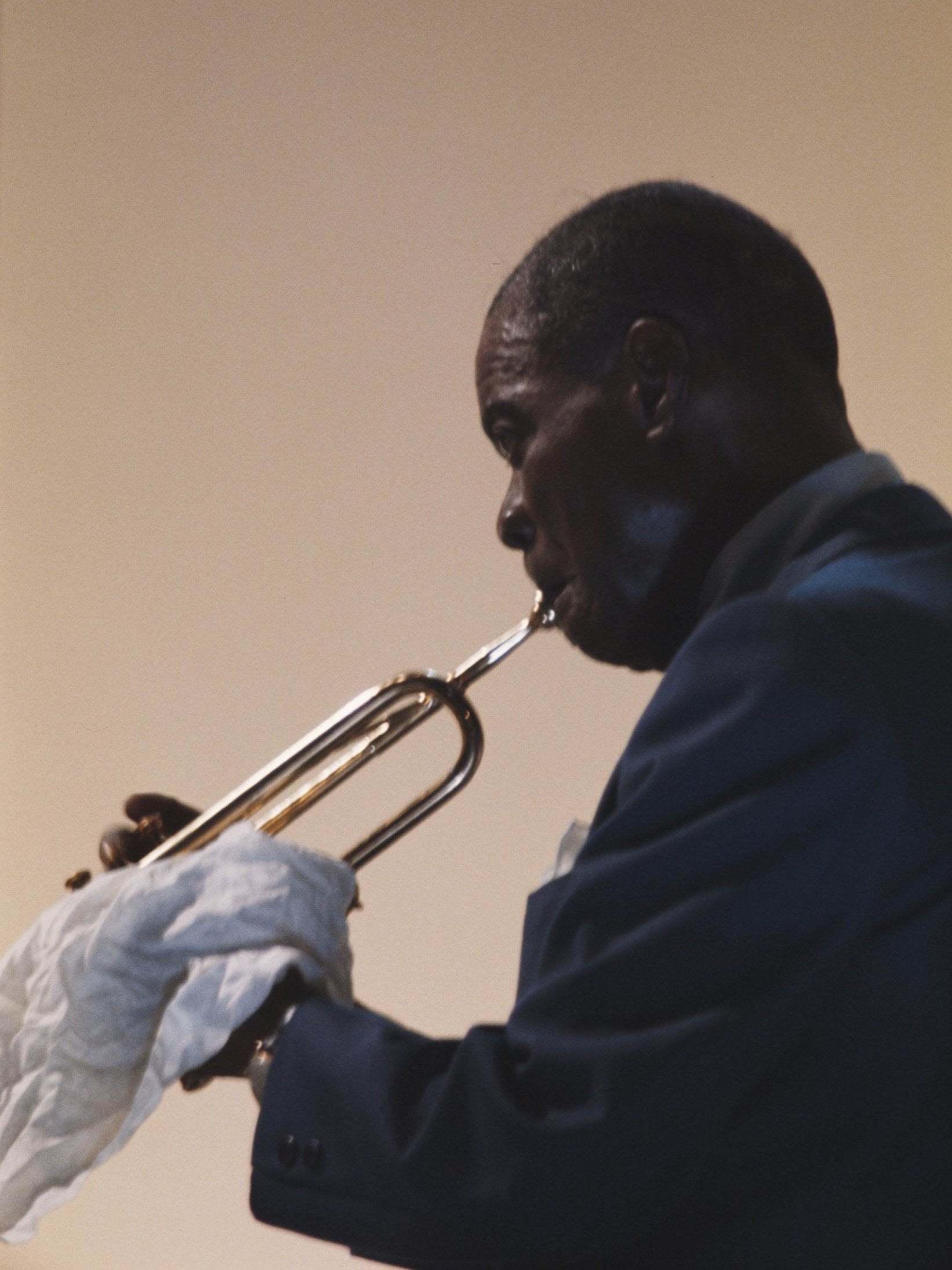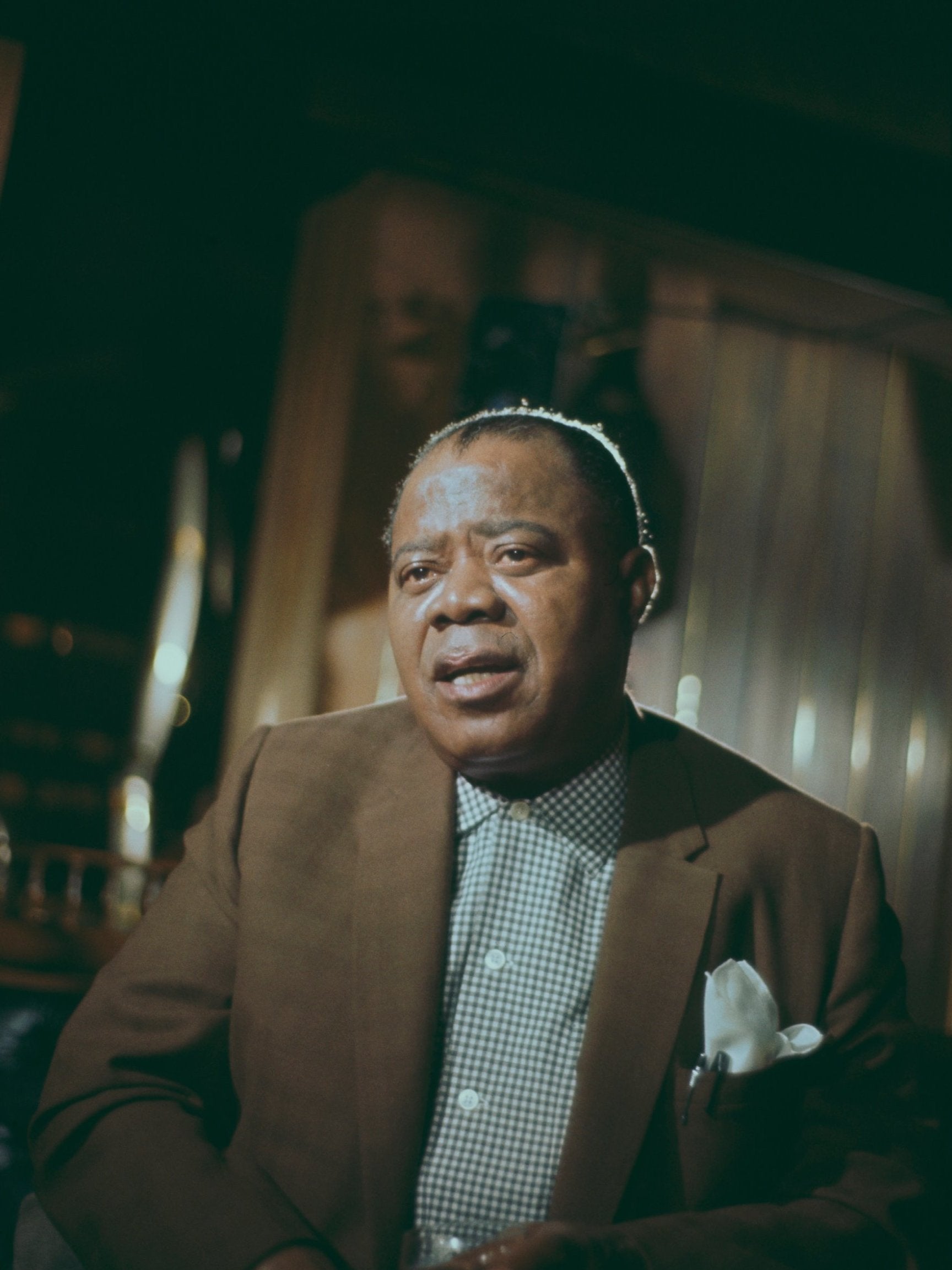How Louis Armstrong's archives give us a better understanding of the artist
Thanks to the digitisation of the legendary jazz musician’s personal writing, recordings and artefacts, everyone can now discover him to be as idiosyncratic an artist as any, and one whose creative instincts grew deeper over time, says Giovanni Russonello

Your support helps us to tell the story
From reproductive rights to climate change to Big Tech, The Independent is on the ground when the story is developing. Whether it's investigating the financials of Elon Musk's pro-Trump PAC or producing our latest documentary, 'The A Word', which shines a light on the American women fighting for reproductive rights, we know how important it is to parse out the facts from the messaging.
At such a critical moment in US history, we need reporters on the ground. Your donation allows us to keep sending journalists to speak to both sides of the story.
The Independent is trusted by Americans across the entire political spectrum. And unlike many other quality news outlets, we choose not to lock Americans out of our reporting and analysis with paywalls. We believe quality journalism should be available to everyone, paid for by those who can afford it.
Your support makes all the difference.Behind his blistering trumpet solos, revolutionary vocal improvising and exuberant stage persona, how did Louis Armstrong see himself? What was it like to be the first pop virtuoso of the recorded era – the man whose earliest releases set the tune for America’s love affair with modern black music, and who went on to become one of history’s most famous entertainers?
Those questions aren’t rhetorical. There’s actually a deep well of resources on hand to help answer them. For his entire adult life, away from the spotlight, Armstrong amassed a huge trove of personal writings, recordings and artefacts. But until this month, you would have had to travel far into central Queens, New York, to find them. Now anyone can access them.
Thanks to a $3m (£2.3m) grant from the Fund II Foundation – run by investor and philanthropist Robert F Smith – the Louis Armstrong House Museum has digitised the entire collection he left behind and made it available to the public at collections.louisarmstronghouse.org.
Armstrong wrote hundreds of pages of memoir, commentary and jokes throughout his life and sent thousands of letters. He made collages and scrapbooks by the score. Over the final two decades of his life, he recorded himself on reel-to-reel tapes constantly, capturing everything from casual conversations to the modern music he was listening to.
All told, Armstrong’s is not just one of the most well documented private lives of any American artist. It’s one of the most creatively documented lives, too.
“Posterity drove him to write manuscripts and make tapes and catalogue everything,” says Ricky Riccardi, the director of research collections at the Louis Armstrong House Museum and a noted Armstrong scholar. “He was just completely aware of his importance and wanting to be in control of his own story.”
And it wasn’t just posterity. The same things that drove him as a performer – faith in unfettered communication, an irreverent approach to the strictures of language, the desire to wrap all of American culture in his embrace – course through his writings, collages and home recordings.
Armstrong had been largely responsible for shaping jazz into the worldly, youth-driven music it became in the 1930s. He emerged as a symbol of racial pride, crossing Tin Pan Alley gentility with street patois, and sometimes singing directly about black frustrations.
But as his career went on, his grinning stage persona – an expansion on the minstrel shows and New Orleans cabarets of his youth – fell out of step with most African-American listeners’ tastes. (“I loved the way Louis played trumpet, man, but I hated the way he had to grin in order to get over with some tired white folks,” Miles Davis wrote in his autobiography.)
With jazz’s identity solidifying as an art music in the 1950s, Armstrong became especially unfashionable to the critical establishment. The autumnal hits he scored in the 1960s, “Hello, Dolly!” and “What a Wonderful World”, seemed only to confirm the media consensus that the times had passed him by.

But these archives contain the tools for a better understanding of Armstrong: as idiosyncratic an artist as any, one whose creative instincts only grew deeper and broader over time.
In part, we see a man attuned to race and politics, who took his role seriously as a global ambassador for American culture and kept a close eye on the achievements of fellow African Americans. When he spoke out against school segregation in Little Rock, Arkansas, in 1957, he surprised the nation, although some activists said it was too little, too late.
The archive, however, shows that he considered it both a proud moment in his career and wholly of a piece with his life up to that point. In the collection is a telegram he wrote to President Dwight Eisenhower on the day the latter announced he would be sending army troops into Little Rock, urging him “to take those little Negro children personally into Central High School along with your marvellous troops”.
And as solicitous as he was, Armstrong was unwilling to let critical judgements define him. He kept a close eye on reviews but wrote acerbically about music critics and sometimes taped his interviews with them – perhaps for evidence, in case they misreported something.
On one tape, from 1959, he barks at a journalist after being asked about changes afoot in jazz. “I just live what I play, and I can’t vouch for the other fellow. As long as I feel and hit the notes and I’ve got my own audience, then no critic in the world can tell me how I should play my horn,” he says.
Scrapbooks
Raised in New Orleans, Armstrong came to fame in his early twenties after joining King Oliver’s Creole Jazz Band in Chicago; his early recordings as a leader, with his Hot Five and Hot Seven, established jazz as a soloist’s music and made him one of the first pop musicians of the radio era. By the 1940s and 1950s he was regularly included on lists of the most admired Americans.
Starting in his twenties, Armstrong frequently clipped newspaper articles about himself and bundled them into scrapbooks. The books began as a tool to convince club owners of his legitimacy, but they turned into a historical record. The dozens of scrapbook binders contained in the archive are a window into his self-image as a celebrity: Armstrong looking at us looking at him.
Armstrong began his career as an idol to many African Americans. Watch the well-circulated video clip of him performing in Copenhagen in 1933 – bountiful and aggressive as he scats over “Dinah”, then carves his way through “Tiger Rag” with a sweltering trumpet solo – and you’ll get why. But as time wore on, many younger people, particularly musicians of the bebop generation, expressed misgivings about his genuflecting stage persona.
Armstrong’s scrapbooks make it clear that he kept a close eye on how he was perceived, as an artist and as a black statesman. When he travelled to Baltimore in the winter of 1931, he donated 300 bags of coal to residents of a needy black neighbourhood and privately saved the news clipping from the Baltimore Afro-American. When his band was arrested in Arkansas simply for travelling in the same bus as its white manager, he saved the article reporting it.
And when a blatantly racist British critic referred to him as “Mr Ugly” the following year (“He looks, and behaves, like an untrained gorilla,” the article read), Armstrong kept a copy of that too. Reading what arts journalism was like in the late 1920s and 1930s, it becomes obvious how narrow the berth was for a public figure like Armstrong to emerge onto the national stage.
Manuscripts
Armstrong wrote constantly – mostly letters and short stories about his life but also in the form of limericks and pages-long jokes. He wrote in a galloping, oddly punctuated style, treating literature almost as an outsider art. Commas turned into apostrophes; jive talk collided with standard English; words were underlined all over. His musical originality is matched on the page.
When Armstrong joined King Oliver’s famed band, he brought along a typewriter. By 1936, when he was in his mid-thirties, he had already published an autobiography. Over the course of his career he wrote more than 10,000 letters to fans, hundreds of pages of personal memoirs and enough lengthy jokes to fill a book.
In 1969 and 1970, with his health failing, Armstrong set about writing a long essay about his relationship with the Karnofskys, a Jewish family in New Orleans. When he was seven he worked as a servant in their house, and they recognised his musical talent early, advancing him a small amount of money to buy his first cornet.
In this essay, which stretches on for 77 pages, Armstrong enshrines a number of other elements of his personal mythology. He reports his birthday as 4 July 1900, an apocryphal but symbolic date he was fond of using (he was actually born one year later). And he describes the importance of the Storyville neighbourhood where he was raised and where much of early jazz was developed.
Just months after he wrote this piece, he died in his sleep at the age of 69. This story would be collected in a posthumous book, Louis Armstrong: In His Own Words, that featured essays from across his career, many of which are included in the Armstrong archive in their original, handwritten form.
Collages
Armstrong’s creative hobbies outside writing were less easily wrangled for posterity or publication. One example: the hundreds of collages that he made over the course of his life, cutting out and combining photographs, illustrations and text.
Starting in the early 1950s, few pieces of paper were safe from Armstrong’s scissors: magazines, risque photographs, even a Christmas card from Richard Nixon wound up cut and collaged. Most of the time, he taped his collages onto reel-to-reel tape boxes; they were purely decorative. Elsewhere, he turned larger pieces of paper into what amounted to a personal hall of fame.
In one such collage, he crammed a page with almost a dozen photos of Jackie Robinson. On another, Duke Ellington and Kermit Parker, the first black man to run for governor as a Democrat in Louisiana, gaze towards each other from across the page.
And on this collage, a photograph of King Oliver is pasted inside an image of Armstrong’s head, as if to make clear how much Armstrong felt he owed to Oliver. To their left are two other trumpeters: Bix Beiderbecke, a prominent jazz star of the 1920s, and Bunny Berigan, who drew heavily from Armstrong’s influence, both as a trumpeter and a vocalist. Other musicians pictured include Duke Ellington, R&B vocalist Ruth Brown, and Big Sid Catlett, an influential early drummer who played with Armstrong’s big band at the height of its popularity.
In a far corner of the image, Franklin Delano Roosevelt, who had been president around the time when most of these musicians were stars, looks on.
The House
When Armstrong died in 1971, his wife Lucille ensured that the house they shared in Queens – the place where he recorded his tapes, made collages and wrote his manifold letters and notes – remained exactly as he had left it.
At first, Armstrong didn’t want the house. But Lucille bought it in 1943, the year after they married, while he was on a lengthy tour. He eventually fell in love with the narrow two-storey brick home, and with the working class block into which it was tucked. Armstrong proudly became an avuncular presence on the block and bragged in a 1971 manuscript that he had watched three generations grow up around him.

When Lucille wanted to upgrade, he insisted they stay. So she made improvements. The ornate, Fifth Avenue-rate bathroom is a prime example. And the “Throne”, as Armstrong called it in his writing, was of prime import.
Armstrong took health and diet very seriously, partly because of having been raised by a single mother who focused, for lack of a doctor, on keeping her children healthy with natural remedies. After Lucille introduced him to Swiss Kriss, an herbal laxative, he became a zealous proponent and offered his endorsement for free.
The couple wrote a diet plan that called for regular consumption of Swiss Kriss, and they circulated it among friends and fans along with a comical photo of Armstrong seated on his decked-out Queens toilet, with his “Satchmo-Slogan” printed below: “Leave it All Behind Ya.”
Playlists
Starting in December 1950, Armstrong used a tape recorder to capture casual conversations, ambient road hangouts, interviews with journalists, radio broadcasts he liked and more. Most often, though, he would simply record his shellac and vinyl discs to tape, consolidating the music and making it easier to carry. He kept careful documentation of the track lists, and together the tapes and their accompanying lists provide a revealing glimpse into his broad music tastes.
Ever the careful documenter, Armstrong wrote out a playlist anytime he recorded music to tape – whether it was a recording of his own concert, a dub of an entire album or a more piecemeal mixtape.
The range of his listening is striking. He was as likely to listen to The Beatles as he was to Rachmaninoff. On one playlist, the vaudeville singer Al Jolson and Miles Davis butt up against each other. “The man was obsessed with all kinds of music,” Riccardi says. “Anywhere he’d go – if he’d go to South America, he’d bring back South American records. If he went to Africa, he’d bring back African records. He’d go to record stores everywhere.”
On a disc marked “Reel 24”, he is listening mostly to the bebop musicians that had succeeded him in the jazz spotlight of the 1940s and 1950s. On the audio of the tape itself, you can hear him announcing the tunes like a radio DJ.
After that tape plays, Armstrong introduces another: a bootleg recording of a jam session at Minton’s, the venue where bebop was born. After he plays it, he expresses approval. “Cats jumpin’, man”, he says, apparently unperturbed by the beboppers’ sometimes-ambivalent relationship to his own legacy. Later on, he jumps to a track of his own, “Among My Souvenirs”. In the handwritten playlist, Armstrong closely notates each turn in the tape, including the moment when he pauses to mention the children playing outside.
These are the children that Armstrong said he was thinking of when he sang his most famous song, “What a Wonderful World”. Here we have their very voices, documented for all time.
© The New York Times
Join our commenting forum
Join thought-provoking conversations, follow other Independent readers and see their replies
Comments